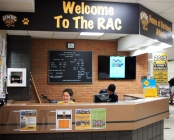
Should the RAC be open 24/7 to accommodate for hectic student schedules?
The idea to make the RAC open 24/7 has recently been presented, but does not prove to be a good or feasible idea for the university to take on. There are simply not enough resources or demand to keep the RAC open around the clock for students.
Businesses and facilities open 24/7 always sound like a good idea, especially for students who run on unusual schedules and have hectic schedules during daytime hours. However, the vast majority of students don’t have bizarre schedules requiring money to be allotted on extra hours for facilities.
With Student Government Association campaigns in progress, candidates have been proposing all kinds of changes for the campus. One idea that has become part of presidential candidate Anthony Jankoski’s platform has been the proposal to keep the Recreational Activities Center open 24/7.
This idea, while at first glance may appear to be a positive change for the campus, only sounds good on paper. The additional resources and student demand for the RAC to stay open 24/7 is currently not possible or realistic.
“I think it’s a great question,” said Gary Wohlstetter, senior associate athletic director of P.E. & recreation. “I think in our current state financially, we could not do it. From a resource standpoint, it is not feasible.”
The RAC has shown its willingness to work with students already, and may be willing to work towards having extended hours. For example, last year the RAC worked with the fraternity Pi Kappa Phi by hosting a wheelchair basketball game.
While the idea to keep the RAC open around the clock seems pretty unlikely, the RAC ultimately works with the students of the university and would not simply throw away an idea just because the chances of it happening were low.
“At UMBC, anything is possible,” said Wohlstetter. “If SGA has a plan, they can roll it out, we’ll hear it out.”
The central focus of the RAC is to create a program and facility that works for and with its students. “Our goal is to provide for students inside and outside of the classroom,” said Wohlstetter.
Even if the RAC and SGA could create a plan that would allow for 24/7 hours to work with given resources and no additional student fees added to tuition, it would most likely prove to be unsuccessful with student response and attendance.
Currently, the busiest weekday hours at the RAC are from 4–8 p.m. and for the weekends, 2–4 p.m. The facility stays open until 10 p.m. on the weekdays and 7 p.m. on the weekends, so if the busiest hours of the gym ends two hours before it closes, then it would seem pointless to extend hours around the clock.
Most universities do not offer a 24/7 gym, so UMBC is missing out on a common campus feature. The RAC has gone through phases with its hours and programs so it can best adapt to the student population’s needs.
They have recently added classes in the morning and according to Wohlstetter, the students who took these classes were asked if they would like the classes to be even earlier, and a majority answered with no.
This idea of a 24/7 gym on campus seems promising as it would allow for workouts at any time of the day. However, in reality, the facility is not currently able to provide the necessary resources or have a large amount of student promise for participation.
Photo Credit: Eva Anzola
Read more stories from: The Retriever Weekly





